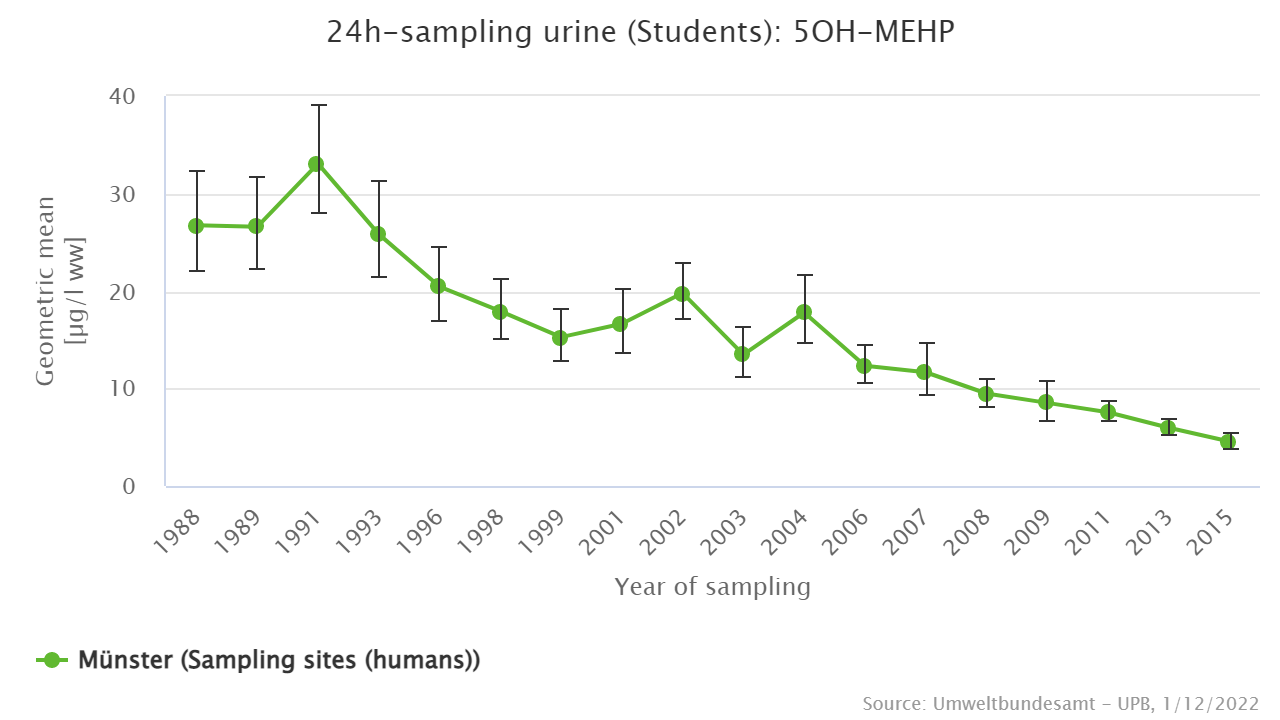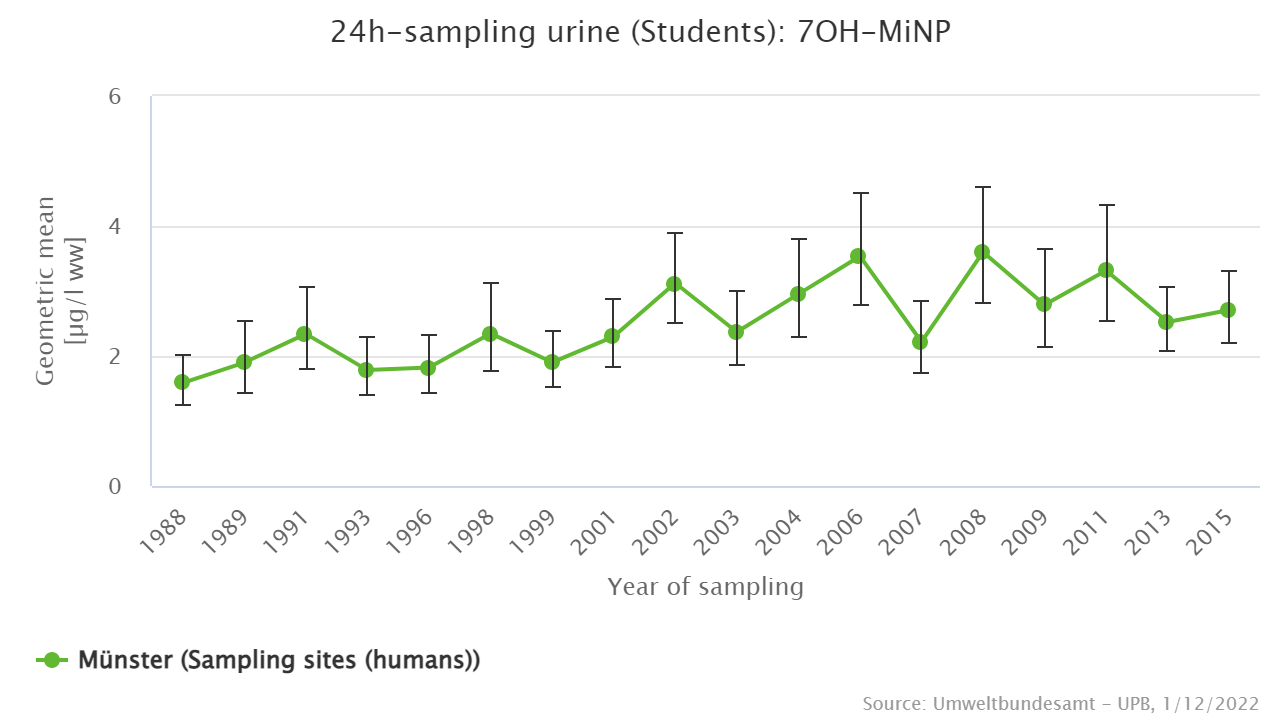Phthalates in human samples
The plasticisers can leave plastic and enter the human body
Phthalates are primarily used as plasticisers for soft PVC. The chemical industry in Western Europe produces around one million tons of phthalates annually. More than 90% go into the production of soft PVC. Phthalates do not form strong chemical bonds in soft PVC, thus they can evaporate from products, such as flooring, wallpaper, or food packaging. Human Biomonitoring demonstrated that everybody in industrialized countries is exposed to phthalates or their degradation products. In three retrospective studies of the Environmental Specimen Bank metabolites of phthalates were detectable in nearly all urine samples indicating a ubiquitous exposure of the German population over the complete study period.
How are phthalates regulated?
Under REACH more than 600 phthalates have been preregistered. The six most commonly utilized phthalates are DiDP (diisodecyl phthalate), DiNP (diisononyl phthalate), DEHP (diethylhexyl phthalate), DnBP (di-n-butyl phthalate), DiBP (diisobutyl phthalate) and BBzP (butylbenzyl phthalate).
In 2011, the EU decided that DEHP, DnBP and BBzP are among the first chemicals the EU is regulating under its REACH programme: Since 1 January 2015 the sale or use of these chemicals is banned. Exceptions require the Commission to authorize the use of specific phthalate products. To use or sell any of these substances, a business would have to demonstrate that safety measures are in place to control risks adequately or that the benefits to the economy and society outweigh the risk for human health and the environment.
In 2005, the member states of the European Union classified DEHP, DnBP, DiBP and BBzP as reproductive toxicants. Since then, these chemicals are not allowed in children’s toys, childcare articles and cosmetics. The use of three other phthalates - DiNP, DnOP (Di-n-octylphthalate) and DiDP - was banned from small toys and childcare articles that children can put in their mouth. These phthalates had been temporarily restricted since 1999.
Analyses of phthalates in Environmental Specimen Bank samples
In three retrospective monitoring studies nearly 1200 archived 24h-urine samples were analyzed for concentrations of primary and/or secondary metabolites of DMP (Di methyl phthalate), DEP (Di ethyl phthalate), BBzP, DiBP, DnBP, DCHP (Di cyclohexyl phthalate), DnPeP (Di-n-pentyl phthalate), DEHP, DiNP, DiDP, DPHP (Di-propyl-heptyl phthalate) und DnOP. Students aged 20-29 years from the University of Münster donated these samples between 1988 and 2015. The first time series covers the sampling years 1988, 1989, 1991, 1993, 1996, 1998, 1999, 2001, and 2003. The overlapping second time series covers the sampling years 2002, 2004, 2006, and 2008.The third the years 2007, 2009, 2011, 2013 and 2015.
Findings
Metabolites of most phthalates were detectable in nearly all urine samples indicating a ubiquitous exposure of the German population over the complete study period. This is well in agreement with similar studies in other industrialized countries and the German Kinder-Umwelt-Survey.
The studies indicate that German adults’ exposure to phthalates decreased over the last 20 years. The levels of DEHP, BBzP and DnBP peaked in the mid 1990s in Environmental Specimen Bank 24h-sampling urine samples. The 95th percentile values demonstrate decreasing trends of internal exposure to DEHP and BBzP and to DnBP. In contrast, DiNP burden increased in the samples. DiNP is also used as substitute for DEHP. The trend for DiBP decreased only in the last time series.


Show all data of the result description
Relevance of the findings
DEHP - are the regulations effective?
The debate about human health risks arising from use of DEHP in plastics started in the 1980s. At that time, DEHP metabolite concentrations were still on the rise in Environmental Specimen Bank samples from female and male students. It was not until the mid 1990s, when the safe use of phthalates in children toys became public concern, that the DEHP level in the samples reached its plateau. DEHP metabolite concentrations started to level-off in 1997, the year Denmark and Spain called for the EU for precautionary regulatory action. Little later the Commission decided for a temporary and then unlimited ban for use of DEHP in children toys in 1999 and 2005, respectively. The temporal trend indicates that chemical industry revaluated the use of DEHP when plans became public to regulate the chemical: In 1997 the DEHP concentrations began to decrease continuously. Since the samples stem from young adults it is obvious that the subsequent shift in the plasticiser market has affected not only children toys but also products which contaminate food products. This is of importance since human phthalate exposure mainly originates from contaminated food products.
By 2008, DEHP metabolite levels in the samples from adults had decreased by half to two thirds compared to levels of the 1980s. Nevertheless still 1% of samples exceeds the BE (biomonitoring equivalents) health guidance values.
Conclusion
The time trend data indicate a step in the right direction but they also demonstrate that the toxicologically questionable phthalates are still used at such a large scale that further regulary action may be warranted. The decreasing trend makes it a high priority to also evaluate exposure to phthalate substitutes like Hexamoll DINCH.
Updated at: 2022-01-12
Recommended profiles
Specimen
-
Student groups with an even number of female and male students at the age of 20 to 29.
-
Particularly suitable matrix for human biomonitoring because chemicals and/or their metabolites excreted with urine have been in direct contact with the organism. Therefore, measurements in urine can give valid information regarding the internal human body burden.
Analytes
-
General-purpose plasticizers for PVC and other polymers
Sampling area
-
4 university cities as sampling areas.
Extended information
Links to external information and legislation
Literature
-
Internal phthalate exposure over the last two decades – A retrospective human biomonitoring study
Wittassek, Matthias; Wiesmüller, Gerhard A.; Koch, Holger M.; Eckard, Rolf; Dobler, Lorenz; Helm, Dieter; Müller, Johannes; Angerer, Jürgen; Schlüter, Christoph
International Journal of Hygiene and Environmental Health 210 (2007), 3-4, 319-333, 2007
-
Trends of the internal phthalate exposure of young adults in Germany - Follow-up of a retrospective human biomonitoring study
Göen, Thomas; Dobler, Lorenz; Koschorreck, Jan; Müller, Johannes; Wiesmüller, Gerhard A.; Drexler, Hans; Kolossa-Gehring, Marike
International Journal of Hygiene and Environmental Health 215 (2011), 1, 36-45, 2011
-
Phthalate metabolites in 24-h urine samples of the German Environmental Specimen Bank (ESB) from 1988 to 2015 and a comparison with US NHANES data from 1999 to 2012
Koch, Holger M.; Rüther, Maria; Schütze, André; Conrad, André; Pälmke, Claudia; Apel, Petra; Brüning, Thomas, Kolossa-Gehring, Marike
International Journal of Hygiene and Environmental Health (2016), online 9 November 2016, 2016
-
Bis-(2-propylheptyl)phthalate (DPHP) metabolites emerging in 24 hour urine samples from the German Environmental Specimen Bank (1999 to 2012)
Schütze, André; Gries, Wolfgang; Kolossa-Gehring, Marike; Apel, Petra; Schröter-Kermani, Christa; Fiddicke, Ulrike; Leng, Gabriele; Brüning, Thomas; Koch, Holger M.
International Journal of Hygiene and Environmental Health (2015), online 1 June 2015, 2015